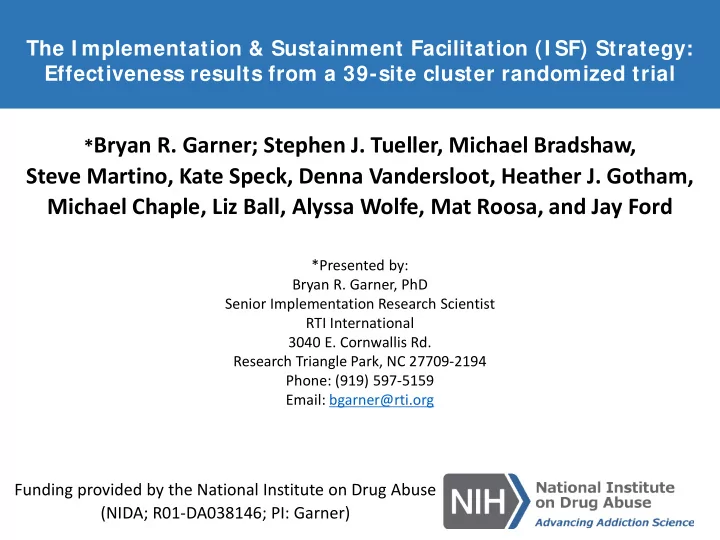

The I mplementation & Sustainment Facilitation (I SF) Strategy: Effectiveness results from a 39-site cluster randomized trial * Bryan R. Garner; Stephen J. Tueller, Michael Bradshaw, Steve Martino, Kate Speck, Denna Vandersloot, Heather J. Gotham, Michael Chaple, Liz Ball, Alyssa Wolfe, Mat Roosa, and Jay Ford *Presented by: Bryan R. Garner, PhD Senior Implementation Research Scientist RTI International 3040 E. Cornwallis Rd. Research Triangle Park, NC 27709-2194 Phone: (919) 597-5159 Email: bgarner@rti.org Funding provided by the National Institute on Drug Abuse (NIDA; R01-DA038146; PI: Garner)
The Substance Abuse Treatment to HI V Care (SAT2HI V) Project (R01-DA038146)
The Substance Abuse Treatment to HI V Care (SAT2HI V) Project (R01-DA038146)
The Substance Abuse Treatment to HI V Care (SAT2HI V) Project (R01-DA038146) Focus of this presentation
I mplementation Effectiveness (Klein & Sorra, 1996; Klein, Conn, & Sorra, 2001) “Implementation effectiveness refers to the consistency and quality of targeted organizational members’ use of a specific innovation .” Klein & Sorra, 1996
I mplementation Effectiveness (Klein, Conn, & Sorra, 2001, p. 812)
Participant Flow Chart
Participant Flow Chart
Participant Flow Chart
Naming, Defining, and Specifying the I mplementation Strategies 1. Name it 2. Define it 3. Specify it a) The Actor b) The Action c) Action Target d) Temporality e) Dose f) Implementation Outcome g) Justification
Addiction Technology Transfer Center (ATTC) implementation strategy A. Centralized technical assistance B. Develop educational materials C. Develop and organize quality monitoring systems D. Develop tools for quality monitoring E. Distribute educational materials F. Conduct educational meetings G. Make training dynamic H. Audit & Provide feedback I. Provide ongoing consultation J. Create a learning collaborative
I mplementation & Sustainment Facilitation (I SF) strategy K. Use an improvement and implementation advisor L. Develop tools for quality improvement M. Organize implementation team meetings N. Identify and prepare champions O. Assess for readiness and identify barriers P. Conduct local consensus discussions Q. Conduct cyclical small tests of change
Addiction Technology Transfer Center (ATTC) implementation strategy
I mplementation & Sustainment Facilitation (I SF) strategy
Strategy dose during preparation phase
Strategy dose during implementation phase
Strategy dose during sustainment phase
Participant Flow Chart
The Substance Abuse Treatment to HI V Care (SAT2HI V) Project (R01-DA038146) ? Focus of this presentation
Methods Sample • 78 staff from 39 AIDS Service Organizations (ASOs; 2 staff per ASO). • 38 staff and 19 ASOs randomized to ATTC condition. • 40 staff from 20 ASOs randomized to ATTC+ISF condition. Outcome • Implementation Effectiveness – A continuous staff measure representing the sum of the standardized cumulative number of MIBIs delivered by BI staff (i.e., consistency) and the cumulative fidelity score of their delivery of the MIBI (i.e., quality). Analysis • Mplus was used to conduct an adjusted multilevel regression analysis focused on the relationship between condition assignment (ATTC = 0; ATTC+ISF = 1) and implementation effectiveness.
Hypothesized Model Assigned to ATTC+ISF condition (relative to ATTC) + Staff-level covariates 1. Age 2. Gender Implementation 3. Race 4. Ethnicity Effectiveness 5. Education level 6. Years of experience 7. Average hours worked per week 8. MI Experience 9. Innovation-values fit
Results Assigned to ATTC+ISF condition (relative to ATTC) β = .43, p = .002 Staff-level covariates 1. Age 2. Gender Implementation 3. Race 4. Ethnicity Effectiveness 5. Education level 6. Years of experience 7. Average hours worked per week 8. MI Experience 9. Innovation-values fit
Conclusions • As part of the SAT2HIV Project, our team was able to advance 39 ASOs across the EPIS continuum. • Results of this cluster-randomized trial support the effectiveness of the Implementation & Sustainment Facilitation (ISF) intervention as an adjunct to the ATTC strategy, at least for implementation effectiveness. • Future research will need to examine the extent to which the current findings can be replicated, improved upon, and generalized to other contexts and EBPs.
Thank you! Bryan R. Garner, PhD Senior Implementation Research Scientist RTI International 3040 E. Cornwallis Rd. Research Triangle Park, NC 27709 - 2194 Phone: (919) 597-5159 Email: bgarner@rti.org
Recommend
More recommend